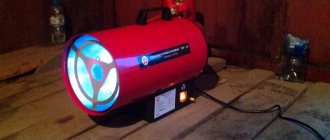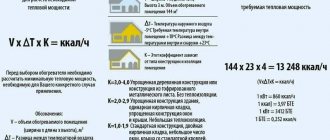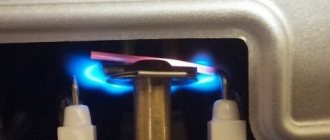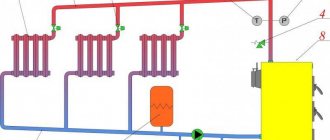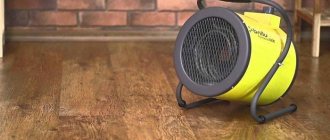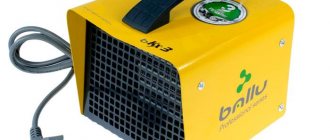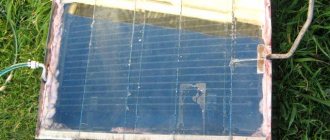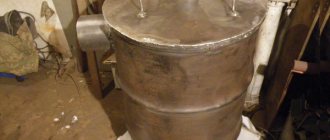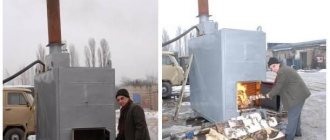The need to quickly heat a room appears very often. In some cases, it is necessary to heat the garage, dry the concrete screed, warm up the barn, basement, or country house. In this case, the best solution would be a heat gun - gas, diesel or electric. It is not necessary to buy a device - you can create a heat gun with your own hands.
You can make a similar gun yourself
General information
It is difficult to find a simpler and more convenient to use device for heating various rooms than a heat gun. This device is a structure consisting of a powerful heating element and a fan, which are located in one housing. A heat gun can quickly heat the air and distribute it just as quickly. It will take a few minutes to heat a small room, and it won’t take much time to heat a large room.
The design of this device is quite simple, so a DIY heat gun almost never fails . You can choose different fuels to operate the device:
- natural gas;
- electricity;
- petrol;
- kerosene;
- diesel fuel.
The heating efficiency of the gun will depend on its power. For home use, a device with a power of 5-12 kW is sufficient. For large premises, equipment with a capacity of 250-350 kW will be required.
To operate the gun you will need fuel
Self-assembly of an electric heat generator
Assembling an electric heat gun with your own hands begins with drawing up a sketch of the device, selecting the necessary parts and tools. In addition, it is very good to replenish your knowledge base with the basics of electrical engineering, strength of materials, and physics. This knowledge will not be superfluous when assembling a heat gun yourself.
Materials needed to create an electric heat generator:
- A sheet of galvanized metal, 0.7-1 mm thick, or a pipe made of a similar material, approximately 25 cm in diameter. The pipe will be the body of the heat gun, so its diameter is selected based on the size of the impeller and the size of the heating element.
- Electric motor with impeller. You can purchase any duct-type supply fan at your nearest specialty store, or you can successfully use motors with an impeller from an old vacuum cleaner.
- A heating element. A simpler and safer option would be to use ready-made tubular heating elements from an old electric furnace with a power of 1.5 - 2 kW. This heating element was given a spiral shape at the factory, which will greatly facilitate the work.
- Copper wire with a cross-section of 2 mm2, ceramic insulator, switch, cable with power plug, 25 A fuse for the heating element.
Tools for assembling an electric heat gun with your own hands:
- Riveting machine.
- Drill with drills.
- Pliers.
- Screwdrivers.
- Insulating tape.
- Soldering iron.
Let's start assembling. Bend a pipe from a galvanized sheet and secure its position with rivets. This will be the body of the heat gun. Install the heating element onto the ceramic insulator and mount it inside the housing at one edge. On the other side of the case, install the fan using standard fasteners. Then, using wires, connect the heating element and the fan to the power cable or switch, providing for the presence of a fuse in the circuit.
Important! When assembling, be careful and follow safety precautions. Failure to properly assemble this unit may result in electrical shock, damage to the power line, or personal injury.
Such a heat gun will have sufficient power to heat a small room with an area of up to 20 m2.
Tip The body of this homemade ash cannon will probably get hot, so be sure to provide a stand with heat-resistant material.
Electric gun
This equipment is the safest and easiest to use. If the area is connected to the power grid, then it is best to make an electric heat gun with your own hands. A homemade device can be useful both during construction and in the future for various personal needs. The name “cannon” itself arose due to the similarity of the round body with a military weapon. The body can also be rectangular or square.
Required materials
Making a heating device is not too expensive. To make an electric gun with your own hands, you will need:
- steel body;
- frame where the structure will be located;
- electric fan;
- heating element;
- wires for connecting the device to the electrical network;
- switch
The housing can be made from galvanized sheet metal or a suitable piece of pipe. For work you will need a metal tool and a welding unit.
To create an electric gun, you will need, at a minimum, a fan.
The body of this device can become very hot during operation. Therefore, you need to choose a fairly thick or heat-resistant metal. In addition, it makes sense to apply thermal insulation to metal elements.
When choosing a heating element, you must not forget that the temperature of the outlet air will depend on the number and power of these heating elements. In this case, the speed of the fan will not affect the temperature, however, the faster this device rotates, the more evenly the heat is distributed throughout the room. That is, the heating element is responsible for the heating temperature, and the fan is responsible for the quality of distribution.
To reduce costs, you can use a heating element from an old iron or other device. In some cases, it makes sense to shorten the length of the gun barrel in order to increase the heating temperature. A suitable electric motor with impeller can be removed from an unwanted vacuum cleaner.
In this video you will learn how to make a cannon:
Manufacturing process
To assemble a heat gun, it is best to first draw a diagram of the heater's electrical circuit. As a rule, ready-made schemes are used.
An electric heat gun is made in the following order:
- First you need to prepare the frame and body of the device.
- Then you need to install one or more heating elements in the center of the body.
- Then you need to connect the power wire to them.
- After installing the fan, connect electricity to it.
- Connect the power cord, cable from the heating elements and fan to the control panel.
- Install a protective grille at the ends of the housing.
During assembly, be sure to insulate all wire connections. After completing the assembly, perform a test run of the heater. If it works normally, without failures, then you can use the equipment for its intended purpose.
The procedure for making a cannon is presented above
Electric heat guns
These heating units are the simplest and most inexpensive, and they do not emit any harmful substances. They use a specially shaped air heating element as a heating element, repeating the roundness of the body.
In fact, the “barrel” of such a gun is empty from the inside; at one end there is an axial fan, and on the other side, where the air comes out, there is an electric heating element. In more powerful models, several heaters are installed. The device can be used in any enclosed space, as long as there is a source of electricity.
For reference. Factory-made units can provide a fairly wide range of thermal powers - from 3 to 60 kW. At the same time, the number of heating elements in them reaches 15 pieces.
Electric appliances are much easier to operate than gas appliances. Therefore, the electric heat gun is equipped with a step-by-step power regulator and overheating protection, and can also be powered from 220 and 380 V networks. Thanks to such a simple design, the electric fan heater is most suitable for both self-production and household use.
Diesel fuel design
In areas where access to power is impossible or limited, it is optimal to make a diesel heat gun with your own hands. It is a little more difficult to make this equipment yourself, unlike its electrical counterpart, since you will need to make two housings and use welding. To heat a room measuring approximately 700 m², about 15 liters of fuel will be required.
Principle of operation
The bottom element in this design is the diesel fuel tank.
A gun is installed directly on top, in which there is a fan and a combustion chamber. Fuel enters the chamber, and the fan transfers heated air. To ignite and transfer fuel, a fuel pump, connecting hose, nozzle and filter will be needed. An electric motor is connected to the fan. Read more: diesel heat guns for heating.
The combustion chamber is installed centrally at the top of the housing. This is an iron cylinder with a diameter approximately 2 times smaller relative to the diameter of the body. Fuel combustion products are removed from the chamber using a vertically installed pipe.
Assembly Features
The lower part must be located at a distance of at least 20 cm from the upper body. To prevent the fuel container from heating up excessively, it must be made of a material with low thermal conductivity. You can also choose a regular metal tank, which must be covered with a thermal insulation layer.
The upper part must be made of thick metal. A piece of metal pipe will do. In the case you need to place:
- fan with electric motor;
- injector with fuel pump;
- combustion chamber with a pipe for removing combustion products.
Afterwards, the fuel pump is attached, and a metal pipe is connected to the tank, with the help of which the fuel is supplied first to the fuel filter, and then to the injector. Protective nets are installed along the edges of the upper body. You need to think about the power supply for the fan to operate in advance. If access to power is limited, you can use a battery.
When operating a diesel heater, safety precautions must be observed. Even at a distance of one meter, the hot air flow can reach 450 degrees. It is not recommended to use this device in enclosed spaces, since the combustion products of diesel fuel pose a danger to humans.
In addition to heaters that run on diesel fuel, other flammable materials are also used for guns, for example, machine oil.
Safety precautions when using guns
Heat guns, especially homemade ones, are devices that pose an increased fire hazard.
Since a diesel heat gun uses an open fire, it is advisable to have the first means of extinguishing fires on hand (a container of sand, a tank of water, a fire extinguisher)
When using them, it is important to follow the safety rules:
- It is necessary to exclude the presence of flammable and combustible substances near the heating device.
- It is strictly forbidden to direct a stream of hot air towards gas cylinders or containers with flammable liquid (for example, gasoline).
- The body of a homemade gun made of metal usually gets very hot during operation, since, unlike factory models, they do not have thermal insulation. To avoid troubles, it is better to include in the design a stable base that prevents the cylinder from rolling, as well as a handle that does not heat up when the device is in use.
- To ignite the burner, it is better to use a piezo lighter with a long handle or provide a built-in device.
- Before turning off the heat gun, it is advisable to let the fan run idle for several minutes, without supplying fuel. This will help cool the unit somewhat.
- Heat guns (especially direct heating) are only allowed to be used in well-ventilated areas. In this case, preference should be given to forced ventilation.
- If the unit is horizontal, its configuration should not be changed.
- Do not plug in the device with wet hands.
In both homemade and factory models, it is important to periodically check the pipeline in order to notice fuel leaks in time.
The appliance should never be left unattended. It is not advisable to use a diesel heat gun in a room where there are children or pets.
Gas heater
The design of gas equipment resembles that of a diesel gun. There is also a combustion chamber located in the housing. Instead of a container for liquid fuel, a liquefied gas cylinder is installed.
As with the use of diesel fuel, the removal of combustion products is of great importance, since in home-made structures it is very difficult to ensure complete combustion of the gas. The air entering the room heats up during contact with the combustion chamber. The burned gas is removed to the street using a special outlet. This indirect heating design is safer than heating using an open fire.
Increased heat transfer
In order to increase heat transfer, plates are most often welded to the combustion chambers - usually 5-10 pieces each. Moreover, the dimensions of the combustion chamber and plates must be smaller than the size of the housing so that they do not touch its walls and cannot overheat.
The body of a gas heating device becomes very hot during operation, so it must be covered with a thermal insulation layer to prevent fire and burns. To assemble a gas structure you will need:
- burner;
- gas cylinder;
- iron body;
- gearbox;
- frame for fixing the body;
- ignition device;
- fan.
The gas cylinder is connected to the reducer, thereby ensuring uniform transportation of fuel to the burner. At the same time, the air near the combustion chamber warms up, and the fan removes it into the room. The assembly principle is almost the same as for a diesel heater.
Tips for use
With a gas gun, you can only use cylinders filled with gas using special equipment. Cylinders that are filled using a homemade method may leak.
When assembling and operating a gas heater, you must adhere to certain rules:
- Use the device for remote ignition, as manual ignition may cause an explosion.
- Gas supply pipes at the connection areas must be sealed.
- Do not leave the device turned on without supervision for an extended period of time.
- Never use cylinders that are filled using a homemade method with a gun.
- Always ensure that the gas cylinder is at a sufficient distance from the heater, otherwise it will overheat and explode.
Another important point is the ratio of the dimensions of the heated room to the power of the gas installation. Do not install a very powerful heater in a small room, as this may cause a fire.
Making a gas heat gun with your own hands
There are various models of gas guns on sale, but many home craftsmen construct such devices on their own. There are no particular difficulties in the design of a gas gun.
To make such a heating device, you need to understand the principle of its operation, have skills in working with welding equipment and take care of the availability of the necessary materials,
Since most home craftsmen plan to use a home-made heat gun to heat garages, they choose the design of an indirectly heated gas gun connected to the chimney. This design allows you to be in a heated room during its operation.
To create a gas gun you will need the following materials:
- a pipe 1 meter long, 180 mm in diameter, intended for the manufacture of the body;
- a pipe of the same length, but with a diameter of 80 mm for the combustion chamber;
- a pipe 0.3 meters long, 80 mm in diameter for the heated air outlet pipe;
- gas burner equipped with piezo ignition;
- any axial fan with a round flange.
See the schematic diagram of a gas heat gun below.
The assembly of a homemade gas gun equipped with a combustion chamber is carried out in the following order:
- Two holes are drilled on opposite sides of a larger diameter pipe. One of them, intended for welding the heated air outlet pipe, must have a diameter of 80 mm. The second hole is drilled with a diameter of 10 mm. It will include a gas hose connected to the burner.
- The combustion chamber is made from a pipe of smaller diameter. To firmly attach it to the pipe, it is necessary to weld plates that hold the structure in the center of the body.
- Then you need to prepare a plug cut from a metal sheet so that it closes the gap between the combustion chamber and the housing. In this case, access to the chamber must be provided to connect it to the chimney.
- The next step will be to assemble the structure. The fins of the combustion chamber must be welded inside the housing, and a pipe must be welded from the outside of its part, through which heated air and a plug will flow into the room. Then the gas burner is installed and firmly fixed, and the fan is mounted.
Assembling a gas gun with direct heating is much simpler, since it consists of a pipe, at one end of which only a burner and a fan are attached. Hot air along with combustion products exits from the opposite side of the pipe.
Rules of care and use
The apparent simplicity of manufacturing a structure can be the cause of many errors. Therefore, the owner of any heat gun must adhere to certain recommendations:
- The pipe for removing combustion products must be located at least 2 m from flammable objects.
- Do not use the heater if there are gasoline vapors in the air. High humidity is also unacceptable.
- If the equipment has air filters, they must be replaced or washed with soap every 700 hours of operation.
- There must be a pause of at least 5 minutes between turning off and then turning on the device.
- The fan must be cleaned at the beginning and end of the heating season.
- Diesel gun fuel filters must be cleaned every 4 months of operation.
- When storing the equipment, it is necessary to cover it with polyethylene or thick cloth so that the device does not become covered with dust.
- Provide manual cooling: turn off the burner and turn off the fan when all equipment has completely cooled down.
- To prevent fuel leakage, the heat gun must be installed only on a stable and level surface.
- Heat guns can only be refueled when they have completely cooled down.
- It is forbidden to block the switched on device, especially the openings for air supply and outlet. It is also prohibited to place things to dry on the equipment that is turned on.
- Only a day's supply of fuel can be stored near the heat gun and other devices. The main stock must be stored in a special room.
The effectiveness of heat guns has long been proven by their practical use: if you need to dry something or heat a room, there is no better option. Moreover, the design of this equipment is very simple, which makes it possible to make this heater yourself. The devices are very powerful, so you need to be very careful when using them.
Types of heat guns and their features
The operating principle of all guns is almost the same - they draw in cold air, heat it and disperse it throughout the room in a warm stream. The main structural elements of heat generators are: housing, motor, fan (except for IR devices) and heating element.
The main difference between devices, which determines their power and productivity, is the energy source.
To heat production areas, high-power industrial guns are used, and for small premises, including residential ones, household appliances with a capacity of 1-10 kW are designed
Let's consider the existing types of heat guns and the nuances of their operation.
Type No. 1 - liquid fuel units
The most powerful guns, widely used for industrial, construction and agricultural needs, operate on liquid fuel (diesel, diesel fuel, gasoline, kerosene and even waste oil). The fuel ignites directly in the gun chamber and heats the air pumped by the compressor to high temperatures.
Thanks to the non-freezing fuel, such units are effective even outdoors at temperatures of -30 degrees and below.
Direct heating devices can only be used in a well-ventilated area, otherwise there is a high risk of carbon monoxide poisoning, but guns with a chimney “produce” clean air without harmful impurities
By type of heating they are divided into:
- Direct-flow devices are the most powerful devices among all types of heat guns, which impress with their productivity. Their efficiency confidently reaches 100%, maximum power is 220 kW, and the outlet air temperature is up to 400 degrees. But, despite such high efficiency, the use of such guns is limited to non-residential buildings where there are no people or other living creatures, and open construction sites. And all because with direct heating, substances harmful to health remain in the hot air stream.
- Indirect heating units have a closed combustion chamber equipped with an exhaust chimney, so they can be used in crowded rooms. And although the efficiency of such devices will be significantly lower than that of direct-flow devices (about 60%), due to minimal power consumption and low fuel cost, they are popular both on an industrial scale and for private use.
Depending on the availability and quality of filters, as well as other design nuances, there are diesel or multi-fuel guns.
The former prefer “winter” diesel fuel, kerosene and diesel fuel, the latter are perfectly accepting of cheaper types of fuel, including waste oil, and therefore are especially in demand for heating car repair shops, gas stations and other premises where this fuel is in abundance.
We have provided an overview of the best manufacturers of direct and indirect heating guns in this article.
Type No. 2 - gas heat generators
Gas heat guns can act as stationary heaters and be connected to the main pipeline with natural gas. But you can also use them as mobile structures if you stock up on a cylinder of liquefied propane/butane, which it is advisable to equip with a reducer for safe operation.
Like liquid fuels, gas guns are divided into direct and indirect heating devices.
Direct-flow gas guns emit much fewer substances harmful to health compared to diesel counterparts, therefore they are widely used on livestock farms and for heating crowded rooms with good ventilation
Operating principle of the gas unit:
- The gas flow enters the burner in the chamber.
- Ignition ignites the fuel and heats the heat exchanger to a high temperature.
- The fan circulates flows of cold and hot air.
- Gas combustion products either remain in the flow (during direct heating) or are discharged into the chimney.
The disadvantages of the device include loud operation (the noise of the fan is also accompanied by loud pops when connected to the cylinder) and the need for regular ventilation of the room.
The power of gas heat generators reaches 140 kW, which is much higher than electrical appliances, but inferior to diesel units. The main advantages are fast heating of the room and low fuel cost.
Type No. 3 - electric heat guns
Inside the metal body of the device there is an open spiral or heating element that converts electric current into thermal energy. Thanks to the operation of the fan, the air circulates along the heating element, increases its temperature and leaves the “barrel” of the gun already warm.
Electric heat guns are a universal solution for heating residential premises and small industrial or commercial buildings where people are constantly present.
Advantages of electric heaters:
- No harmful fumes - the device is environmentally friendly and does not pollute the air from waste fuel.
- Availability of energy source - for low-power devices, a conventional power supply of 220 W is sufficient, but devices with characteristics of 5 kW or more will require connection to a three-phase network.
- Low price - electrical appliances belong to the most budget segment of heat guns.
- Ability to work at low temperatures.
- No need to refuel.
In addition to being “tied” to electricity, one of the disadvantages is the low power of the device (from 1 to 45 kW) - for open areas or poorly insulated buildings they are ineffective. Also, heating elements dry out the air greatly, so the room will have to be ventilated regularly. Well, the main disadvantage of any electrical equipment is the impressive bills for paying for electricity.
Type No. 4 - water and infrared devices
And let’s finish our review of the range with two types of heat generators, which have significant structural differences from other guns.
In infrared devices, thermal energy is converted into a flow of infrared radiation, which heats the air a second time, because the bulk of the heat goes to the objects at which the “barrel” is directed. Therefore, such heaters are widely used in severe frosts to start equipment, as well as on construction sites - for drying materials, screeds, plaster, paint and varnish products. The device itself runs on DP or diesel fuel.
IR guns are effective for heating equipment or other objects in open space - their operation is not hampered by either frost or strong wind
The more “fins” on the outer body of the unit, the faster the room will heat up, and when the desired temperature is reached, the device will automatically stop the blowing using the built-in thermostat
The design of the water gun is complemented by a heat exchanger with hot water. In fact, these are familiar air heaters or an additional battery with a fan, which is connected to the central heating system.
The essence of the device’s operation is simple - circulating hot water transfers its heat to the heat exchanger pipes, which heat the air, and the fan distributes it throughout the entire volume of the room.
DIY indirect heating gas gun (heat exchanger)
While the construction of the CNC machine was suspended, I decided to start a topic and highlight my solution to the garage heating problem. It was heated by an ordinary 18 kW gas gun. This power is enough to raise the temperature to a comfortable 15-18 degrees in any frost (the garage is the last one in the row, the walls are made of reinforced concrete slab, nothing is insulated). There is a problem: with the arrival of cold weather, the hardware in the garage has a tendency to become rusty due to condensation. The gun already exists and the simplest solution I saw was to create a heat exchanger and remove combustion products to the outside. I wanted the heat exchanger to be simple (for quick creation) and effective. Therefore, at first the choice fell on a “pipe-in-pipe” type option: two coaxial pipes, the combustion products move along the inner one and are discharged outside, and the forced movement of the garage atmosphere in countercurrent (towards the combustion products) is organized along the outer one (in the cavity between the pipes). The efficiency will depend on the length of the pipes and, according to estimates, 5-7 meters should have been enough (for pipe diameters of 200 and 300 mm). The heat exchanger is too big.
The second option was to use car parts. In theory, the engine radiator should be capable of dissipating several tens of kilowatts of thermal energy. The estimated area of one radiator was equivalent to a 6-meter pipe, so at the disassembly site a pair of classic radiators, a fan from the 10th family and an additional pump from a gazelle were purchased at a low price. In the hardware store, parts of a plastic water pipe are found, and an old computer power supply was found in the bins.
This is what the test bench looks like for the applicability of parts.
The fan is powered by 5V, otherwise its power and noise are excessive. In the future, it would be ideal for him to make smooth adjustment and supply full 12V from the standard temperature sensor built into the radiator in case of overheating. The system is filled with the cheapest antifreeze (eight liters included). For the test, I placed the gun almost point-blank to the radiator, the distance between them was about 15 mm, at this distance almost the entire hot flow passed through the radiator. Hot is an understatement; at the exit from the gun the stream is red-hot and flammable. However, after passing through the radiator the air became warm to the touch, not even hot. and this despite the fact that less than a quarter of the radiator area was working! I let the system run for about 40 minutes to fully warm up. The antifreeze warmed up to 60 degrees and flowed from all the cracks (from under the caps, due to the lack of an expansion tank) and, in principle, the system demonstrated the stability of heat transfer from one radiator to another. Great.
The next check will be with deflectors: to expand the flow from the gun to the entire area of the radiator and a collector to remove combustion products into the pipe. At the same time, I’ll try to get a thermometer and measure the efficiency of the radiator by measuring the temperature at the inlet and outlet. Pairing a round gun with a rectangular radiator is quite a task. A model was drawn and the following development was obtained.
I transferred it from paper to galvanized steel and cut it out.
To be continued…
